Been trying to figure this out for a while now and after a couple hours of searching for a solution I decided it was time to ask.
I have a tableview that gets populated by custom UITableViewCells and currently when you tap on a cell it takes you to a detail view.
Within the custom cell there is an image, I would like the user to be able to tap on that image and segue to a popover VC that shows the image.
What I'm having trouble with is creating the segue when the image is tapped.
In the file for the custom cell, I've set up a tap gesture recognizer on the image (pTap):
override func awakeFromNib() {
super.awakeFromNib()
let tap = UITapGestureRecognizer(target: self, action: #selector(PostCell.voteTapped(_:)))
let ptap = UITapGestureRecognizer(target: self, action: #selector(PostCell.imageTapped(_:)))
tap.numberOfTapsRequired = 1
ptap.numberOfTapsRequired = 1
voteImage.addGestureRecognizer(tap)
voteImage.userInteractionEnabled = true
featuredImg.addGestureRecognizer(ptap)
featuredImg.userInteractionEnabled = true
}
I also have a function in the custom cell file for the tap:
func imageTapped(sender: UIGestureRecognizer) {
print("image tapped")
}
In my view controller file I've added a segue in did select row at index path:
func tableView(tableView: UITableView, didSelectRowAtIndexPath indexPath: NSIndexPath) {
let post: Post!
if inSearchMode {
post = filteredVenues[indexPath.row]
} else {
post = posts[indexPath.row]
}
print(post?.venueName)
performSegueWithIdentifier("imageTapped", sender: nil)
performSegueWithIdentifier("DetailsVC", sender: post)
}
Also, in the storyboard I have created a segue from the VC that holds the tableview with the custom cells to the VC I'd like to show when the image is tapped.
I've tried several different methods of getting this to work and haven't had any luck, the code you see above are what remains after my many failed attempts. I feel that the function for the tap in the custom cell file and the segue in the VC file are a part of the solution so that is why I have left them in.
Any help would be appreciated. Thanks!
Updates to code from answers below:
Added protocol
protocol ImageSegueProtocol: class {
func imageTapped(row: Int)
}
class PostCell: UITableViewCell {
Added IAB Func
@IBAction func imageTapped(sender: UIGestureRecognizer) {
guard let row = row else { return }
delegate?.imageTapped(row)
print("image tapped func")
}
Declared delegate in the Main VC
weak var delegate:postCell?
Assigned Delgate
func tableView(tableView: UITableView, cellForRowAtIndexPath indexPath: NSIndexPath) -> UITableViewCell {
//let post = posts[indexPath.row]
if let cell = tableView.dequeueReusableCellWithIdentifier("PostCell") as? PostCell {
var img: UIImage?
var vImg: UIImage?
postCell?.delegate = self
Added extension function
extension FeedVC: ImageSegueProtocol {
func imageTapped(row: Int) {
if inSearchMode == true {
let object = filteredVenues[row]
performSegueWithIdentifier("imageTapped", sender: object)
print("ext func")
} else {
let object = posts[row]
performSegueWithIdentifier("imageTapped", sender: object)
print("ext func")
}
}
